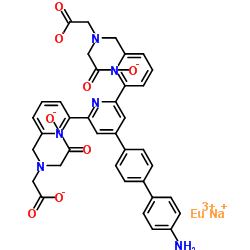601494-52-4
| 中文名 | ATBTA-铕[III] |
|---|---|
| 英文名 | sodium,2-[[6-[4-[4-(4-aminophenyl)phenyl]-6-[6-[[bis(carboxylatomethyl)amino]methyl]pyridin-2-yl]pyridin-2-yl]pyridin-2-yl]methyl-(carboxylatomethyl)amino]acetate,europium(3+) |
| 中文别名 |
ATBTA-铀[III]
ATBTA-铕 |
| 英文别名 |
ATBTA-Eu3+
Europium(3+) sodium 2,2',2'',2'''-{[4'-(4'-amino-4-biphenylyl)-2,2':6',2''-terpyridine-6,6''-diyl]bis(methylenenitrilo)}tetraacetate (1:1:1) Europium(3+) sodium 2,2',2'',2'''-{[4'-(4'-aminobiphenyl-4-yl)-2,2':6',2''-terpyridine-6,6''-diyl]bis(methylenenitrilo)}tetraacetate (1:1:1) |
| 描述 | ATBTA-Eu3+ 是一种铕螯合物,具有荧光,能用于 DNA 标记。 |
|---|---|
| 相关类别 | |
| 参考文献 |
| 分子式 | C37H30EuN6NaO8 |
|---|---|
| 分子量 | 861.62 |
| 精确质量 | 862.123474 |
| PSA | 190.20000 |
| LogP | 2.95520 |
| 储存条件 | 冰箱内 |
| 计算化学 | 1.疏水参数计算参考值(XlogP):无 2.氢键供体数量:1 3.氢键受体数量:14 4.可旋转化学键数量:12 5.互变异构体数量:无 6.拓扑分子极性表面积232 7.重原子数量:53 8.表面电荷:0 9.复杂度:1040 10.同位素原子数量:0 11.确定原子立构中心数量:0 12.不确定原子立构中心数量:0 13.确定化学键立构中心数量:0 14.不确定化学键立构中心数量:0 15.共价键单元数量:3 |
|
ATBTA-Eu3+
Revision number: 1
SAFETY DATA SHEET Section1. BASE INFORMATION ATBTA-Eu3+ Product name:
Revision number:1
Section2. HAZARDS IDENTIFICATION Classification of the GHS PHYSICAL HAZARDSNot classified HEALTH HAZARDSNot classified Not classified ENVIRONMENTAL HAZARDS GHS label elements None Pictograms or hazard symbols Signal wordNo signal word None Hazard statement Precautionary statementsNone Section3. COMPOSITION/INFORMATION ON INGREDIENTS Substance/mixture:Substance ATBTA-Eu3+ Component(s): Percent:>90.0%(LC)(T) CAS Number:601494-52-4 Synonyms:Sodium [4'-(4'-Amino-4-biphenylyl)-2,2':6',2''-terpyridine-6,6''- diylbis(methyliminodiacetato)]europate(III) Chemical Formula:C37H30EuN6NaO8 Section4. FIRST AID MEASURES Inhalation:Remove victim to fresh air and keep at rest in a position comfortable for breathing. Get medical advice/attention if you feel unwell. Skin contact:Remove/Take off immediately all contaminated clothing. Rinse skin with water/shower. If skin irritation or rash occurs: Get medical advice/attention. Eye contact:Rinse cautiously with water for several minutes. Remove contact lenses, if present and easy to do. Continue rinsing. If eye irritation persists: Get medical advice/attention. Ingestion:Get medical advice/attention if you feel unwell. Rinse mouth. Protection of first-aiders:A rescuer should wear personal protective equipment, such as rubber gloves and air- tight goggles. Section5. FIRE-FIGHTING MEASURES Suitable extinguishingDry chemical, foam, water spray, carbon dioxide. media: Specific hazards:Take care as it may decompose upon combustion or in high temperatures to generate poisonous fume. ATBTA-Eu3+ Section5. FIRE-FIGHTING MEASURES Specific methods:Fire-extinguishing work is done from the windward and the suitable fire-extinguishing method according to the surrounding situation is used. Uninvolved persons should evacuate to a safe place. In case of fire in the surroundings: Remove movable containers if safe to do so. Special protectiveWhen extinguishing fire, be sure to wear personal protective equipment. equipment for firefighters: Section6. ACCIDENTAL RELEASE MEASURES Use personal protective equipment. Keep people away from and upwind of spill/leak. Personal precautions, protective equipment and Entry to non-involved personnel should be controlled around the leakage area by emergency procedures: roping off, etc. Environmental precautions: Prevent product from entering drains. Methods and materials for Sweep dust to collect it into an airtight container, taking care not to disperse it. containment and cleaning Adhered or collected material should be promptly disposed of, in accordance with up: appropriate laws and regulations. Section7. HANDLING AND STORAGE Handling Handling is performed in a well ventilated place. Wear suitable protective equipment. Technical measures: Prevent dispersion of dust. Wash hands and face thoroughly after handling. Use a local exhaust if dust or aerosol will be generated. Advice on safe handling:Avoid contact with skin, eyes and clothing. Storage Storage conditions:Keep container tightly closed. Store in a cool and dark place. Store under inert gas. Store away from incompatible materials such as oxidizing agents. Law is followed. Packaging material: Section8. EXPOSURE CONTROLS / PERSONAL PROTECTION Engineering controls:Install a closed system or local exhaust as possible so that workers should not be exposed directly. Also install safety shower and eye bath. Personal protective equipment Respiratory protection: Dust respirator. Follow local and national regulations. Hand protection:Protective gloves. Eye protection:Safety glasses. A face-shield, if the situation requires. Skin and body protection: Protective clothing. Protective boots, if the situation requires. Section9. PHYSICAL AND CHEMICAL PROPERTIES Physical state (20°C):Solid Form:crystal - powder Color:Very pale yellow - Yellow red Odor:No data available pH: No data available Melting point/freezing point:No data available Boiling Point/Range:No data available Flash Point:No data available Explosive limits Lower:No data available Upper:No data available Density:No data available Solubility:Soluble in : Water Section10. STABILITY AND REACTIVITY Stability:Stable under proper conditions. No special reactivity has been reported. Reactivity: Conditions to avoid:Air-sensitive ATBTA-Eu3+ Section10. STABILITY AND REACTIVITY Incompartible materials: oxidizing agents Hazardous Decomposition Carbon monoxide, Carbon dioxide, Nitrogen oxides (NOx) Products: Section11. TOXICOLOGICAL INFORMATION Acute Toxicity:No data available Skin corrosion/irritation: No data available Serious eyeNo data available damage/irritation: Germ cell mutagenicity: No data available Carcinogenicity: IARC =No data available NTP =No data available Reproductive toxicity:No data available Section12. ECOLOGICAL INFORMATION Ecotoxicity: Fish:No data available No data available Crustacea: Algae:No data available Persistence / degradability: No data available BioaccumulativeNo data available potential(BCF): Mobillity in soil No data available log Pow: Soil adsorption (Koc):No data available No data available Henry's Law constant(PaM3/mol): Section13. DISPOSAL CONSIDERATIONS Recycle to process, if possible. Consult your local regional authorities. You may be able to dissolve or mix material with a combustible solvent and burn in a chemical incinerator equipped with an afterburner and scrubber system. Observe all federal, state and local regulations when disposing of the substance. Section14. TRANSPORT INFORMATION Does not correspond to the classification standard of the United Nations Hazards Class: UN-No:Not Listed Section15. REGULATORY INFORMATION Safe management ordinance of dangerous chemical product (State Council announces on January 26, 2002): Safe use and production, the storage of a dangerous chemical, transport, loading and unloading were prescribed. ATBTA-Eu3+ SECTION 16 - ADDITIONAL INFORMATION N/A |


